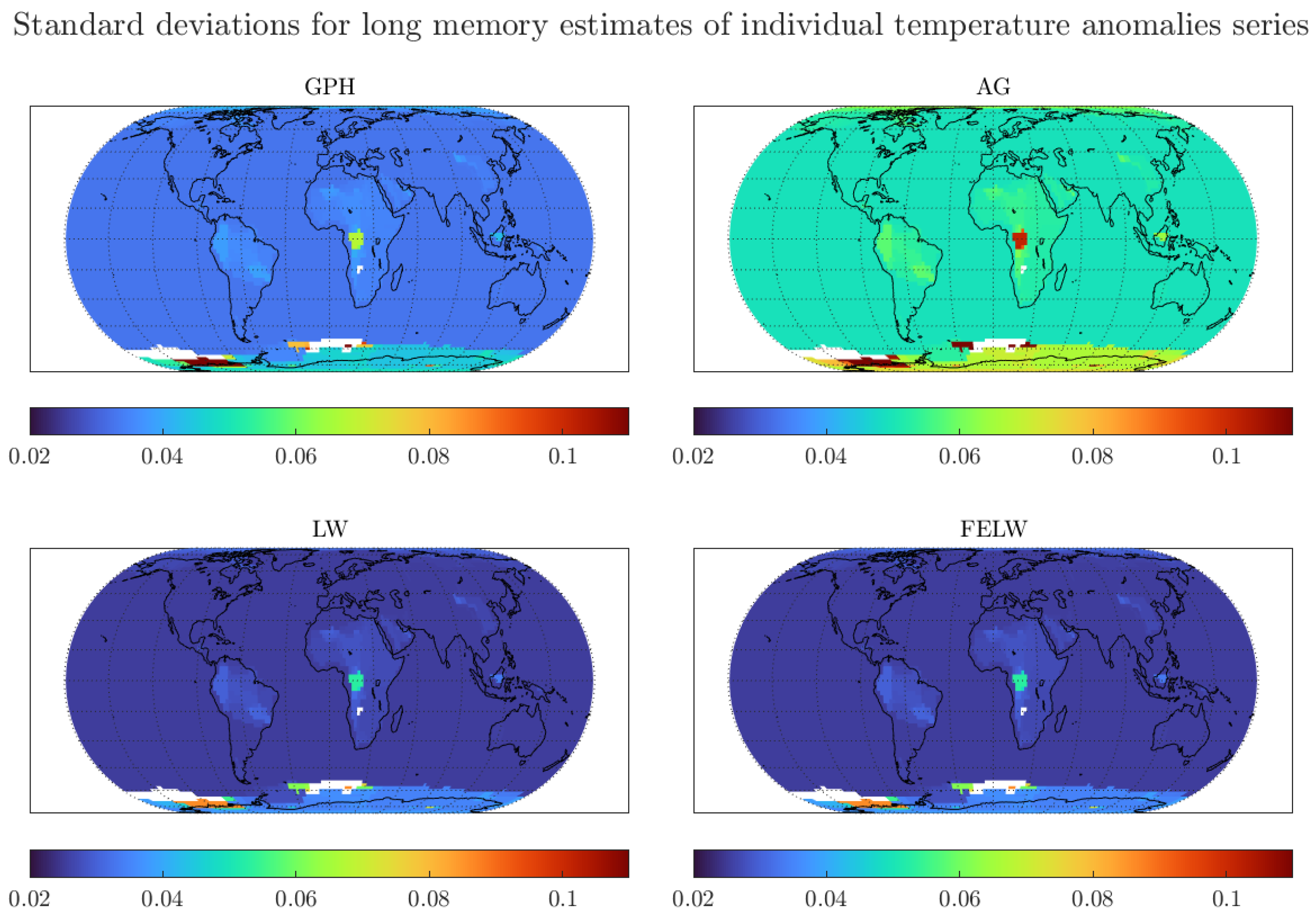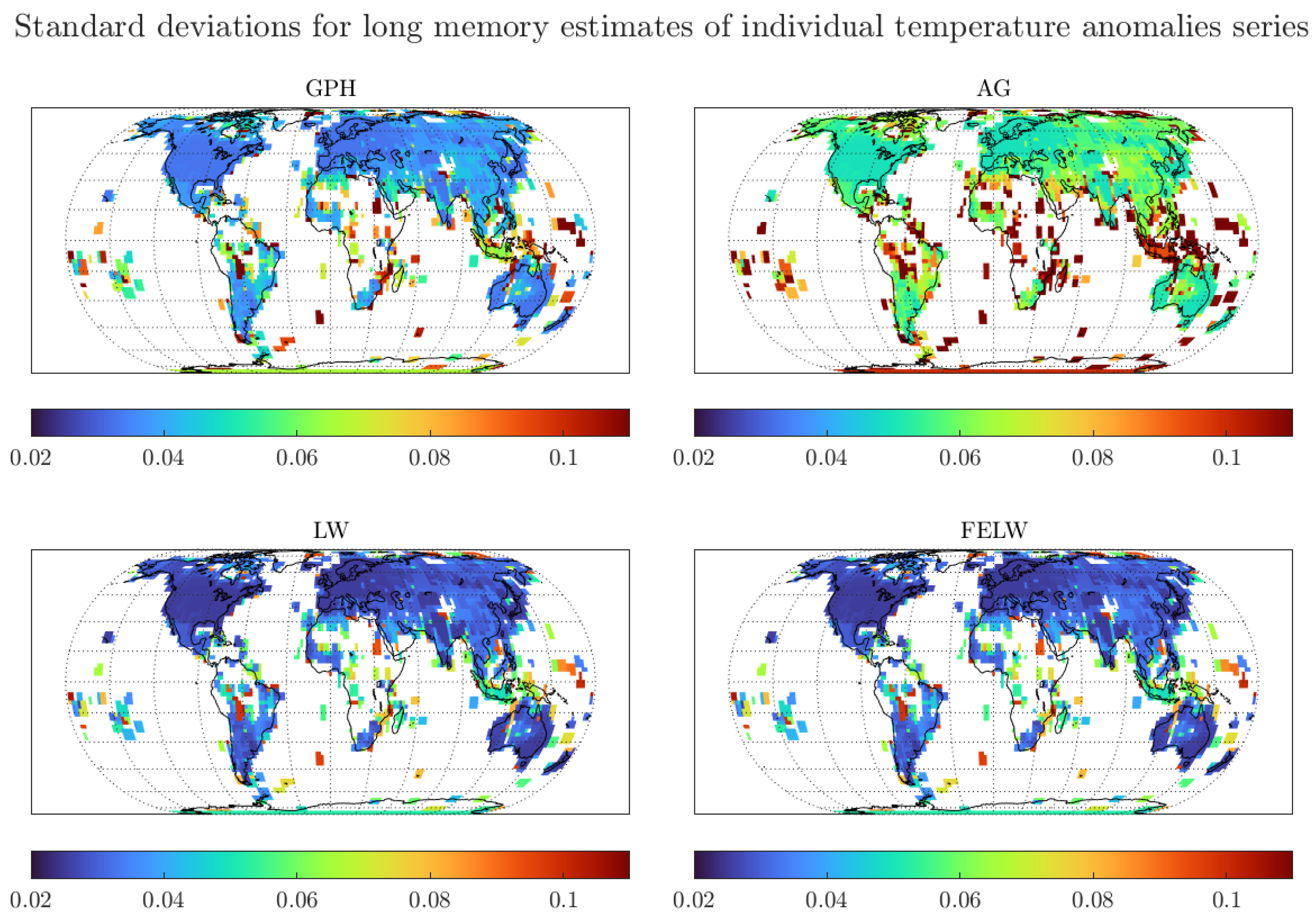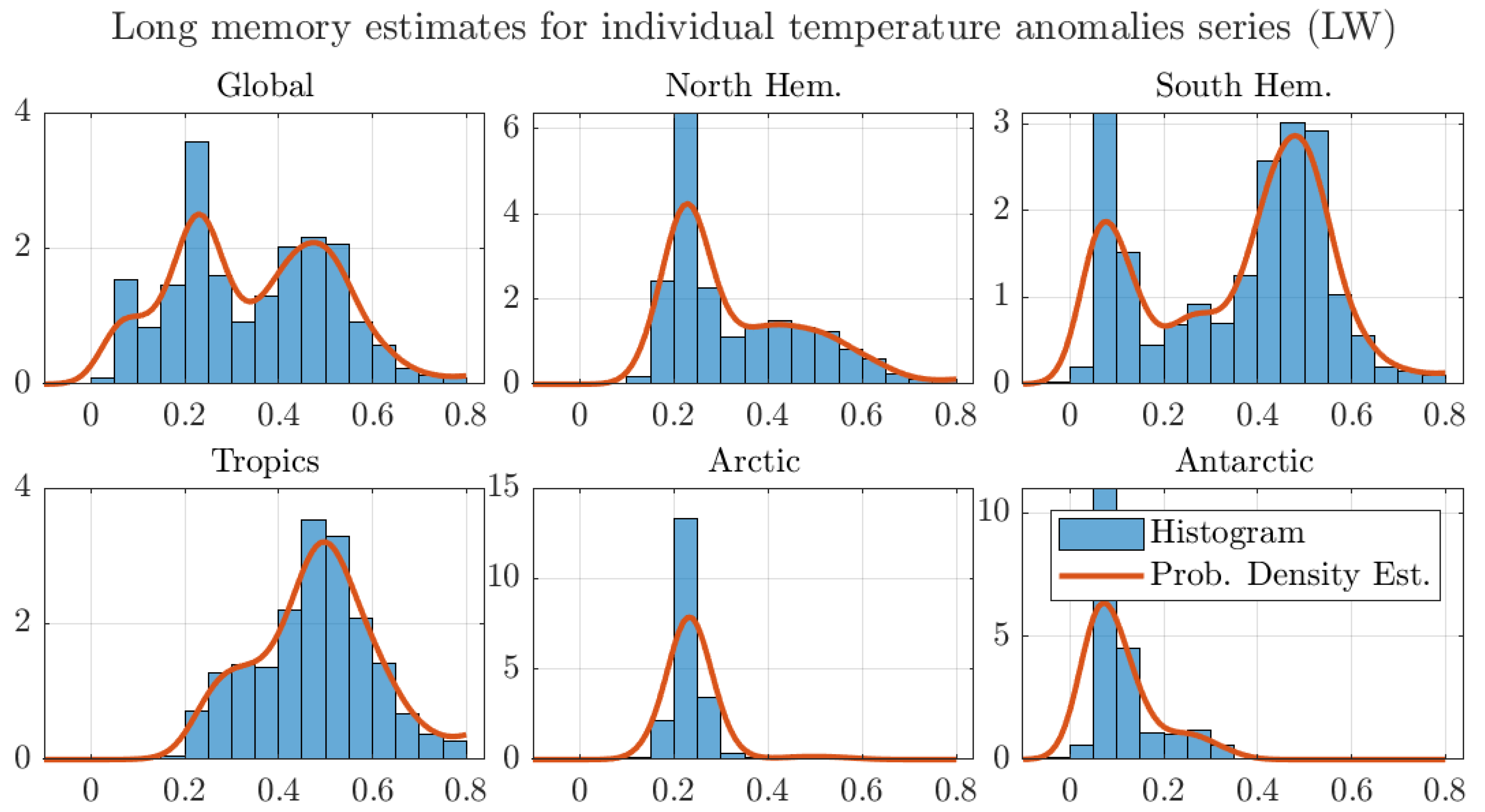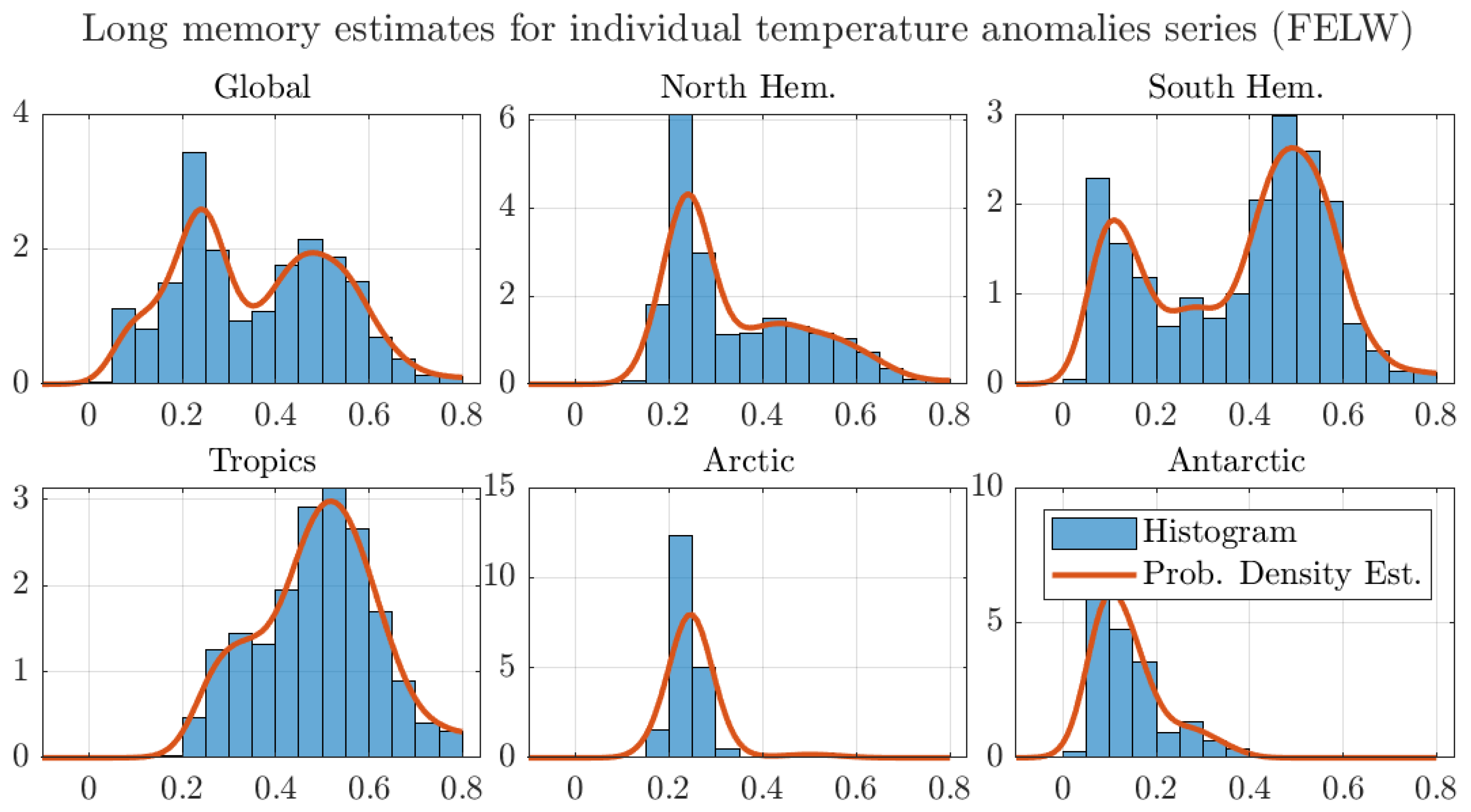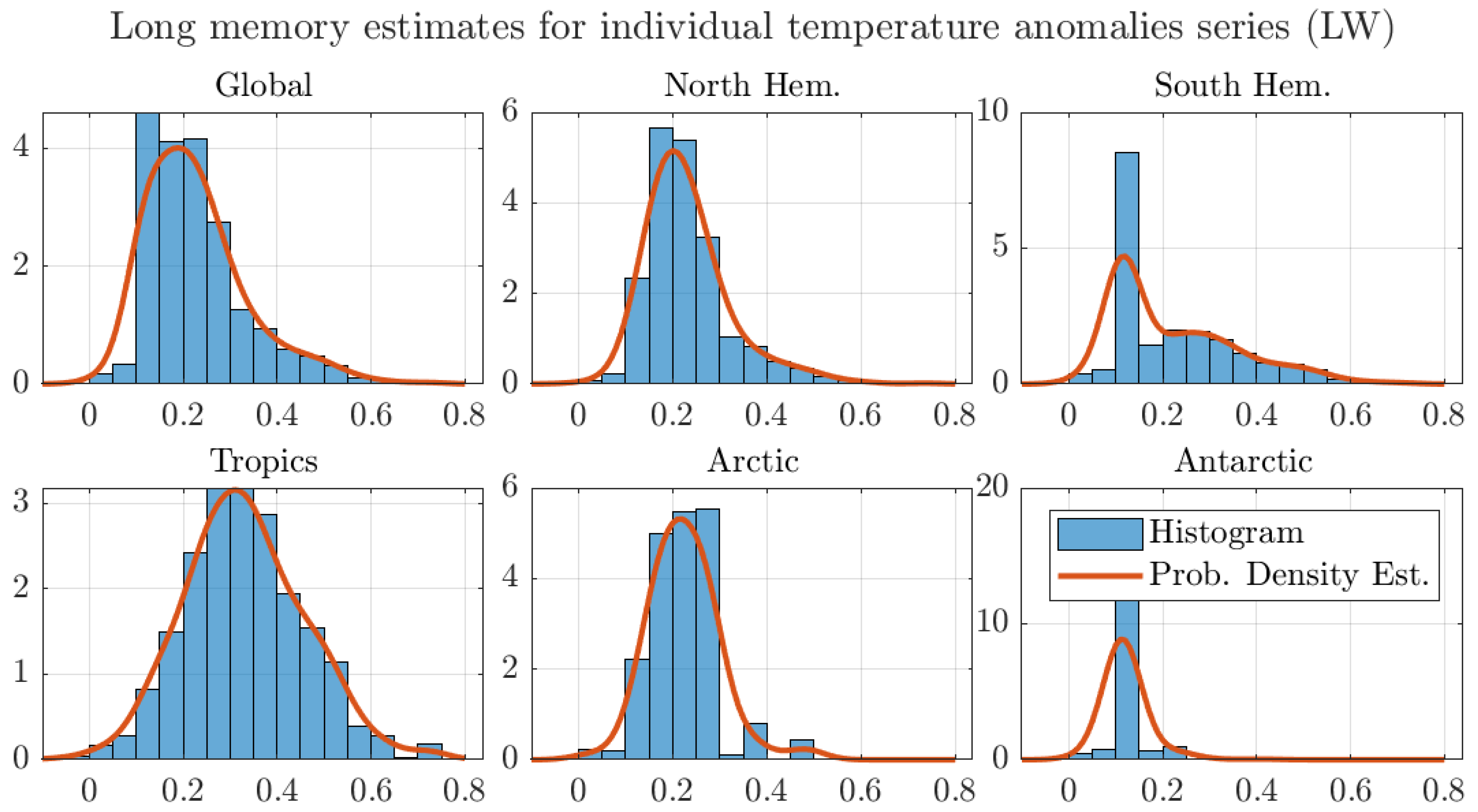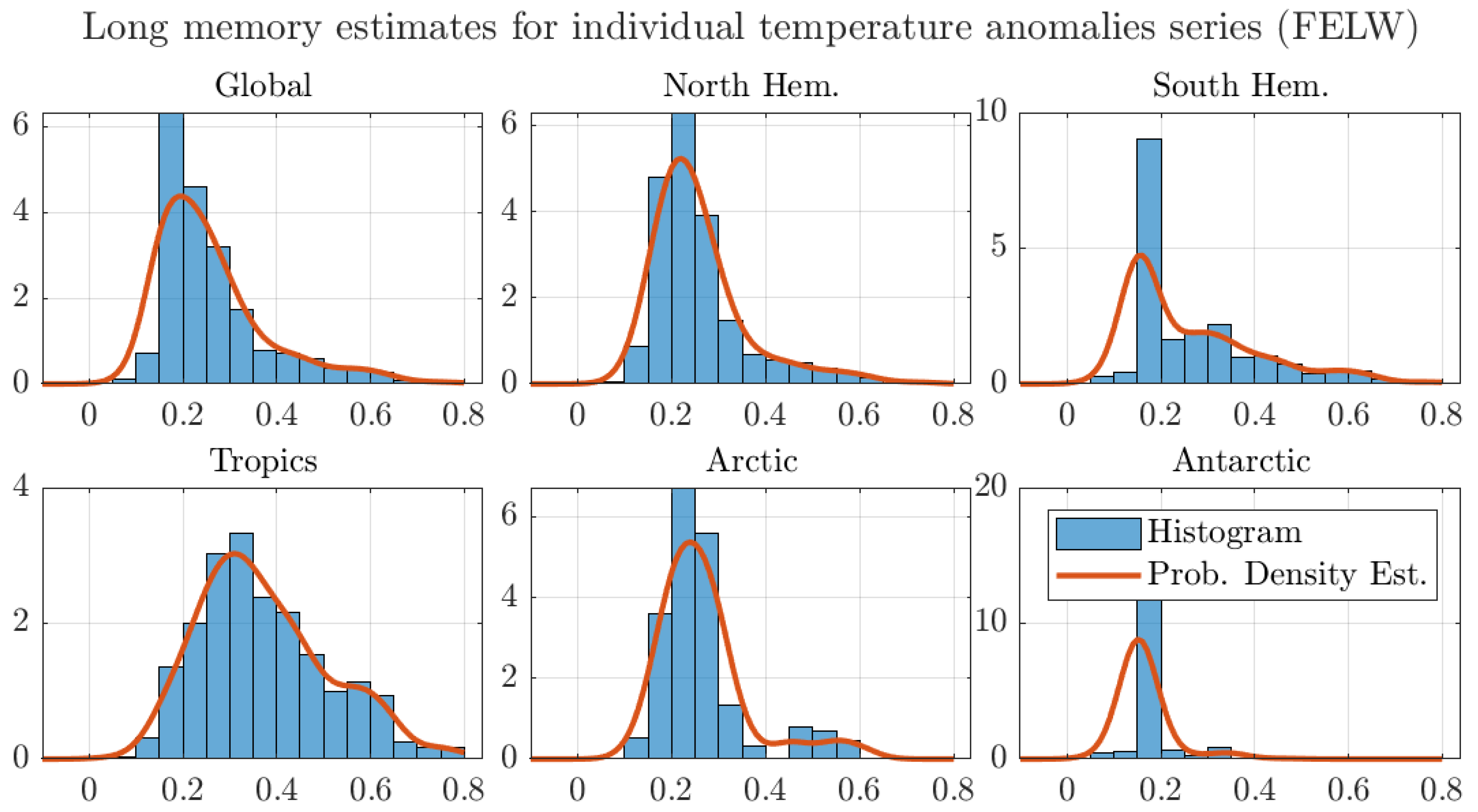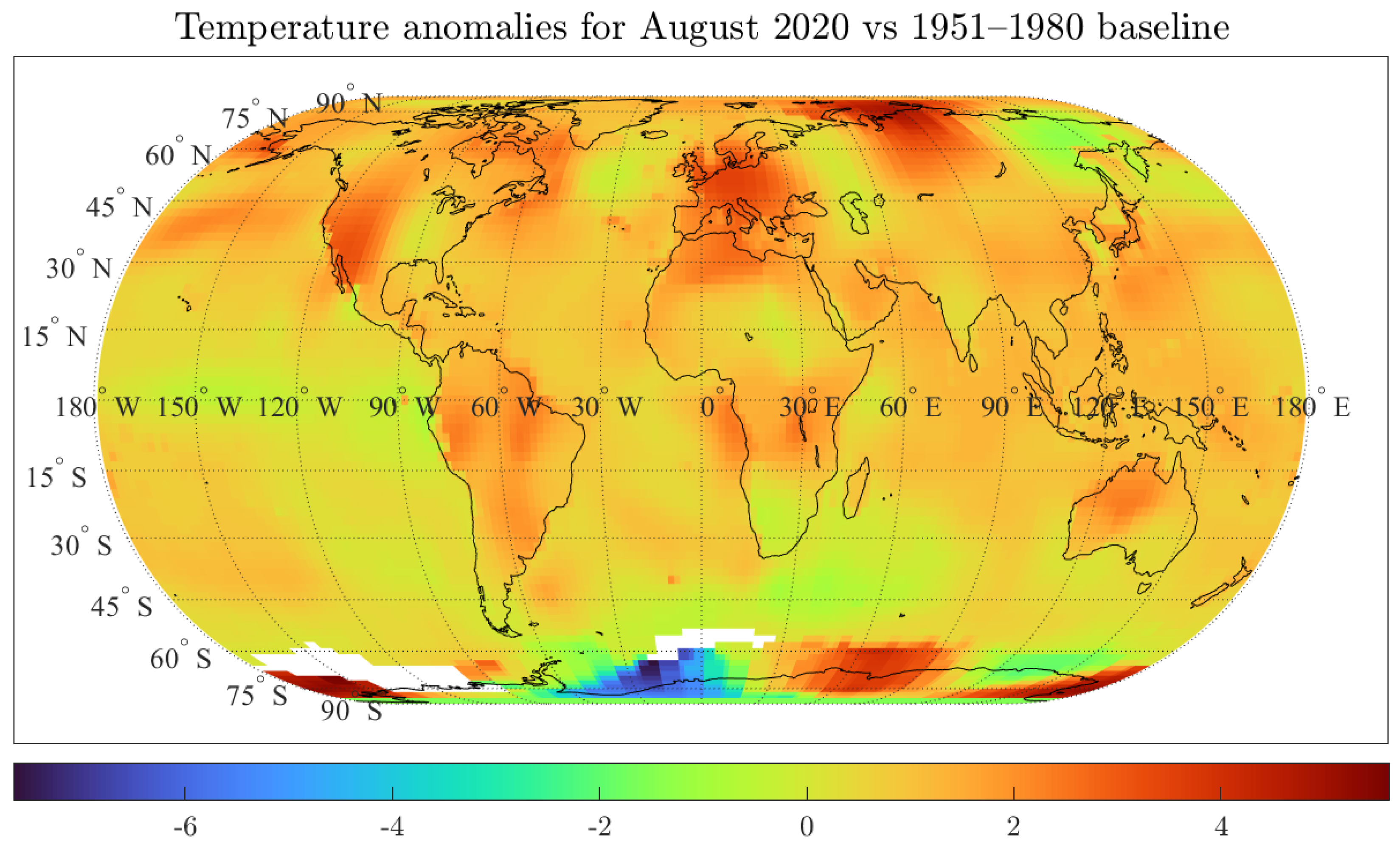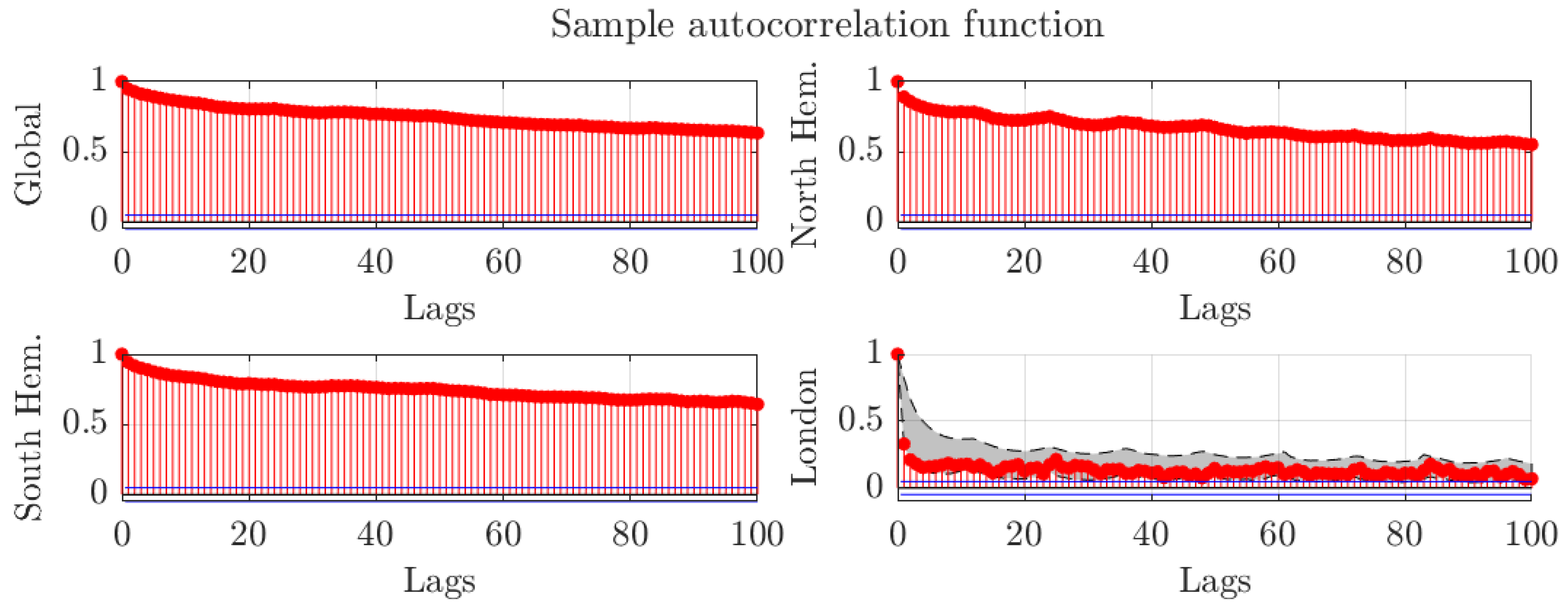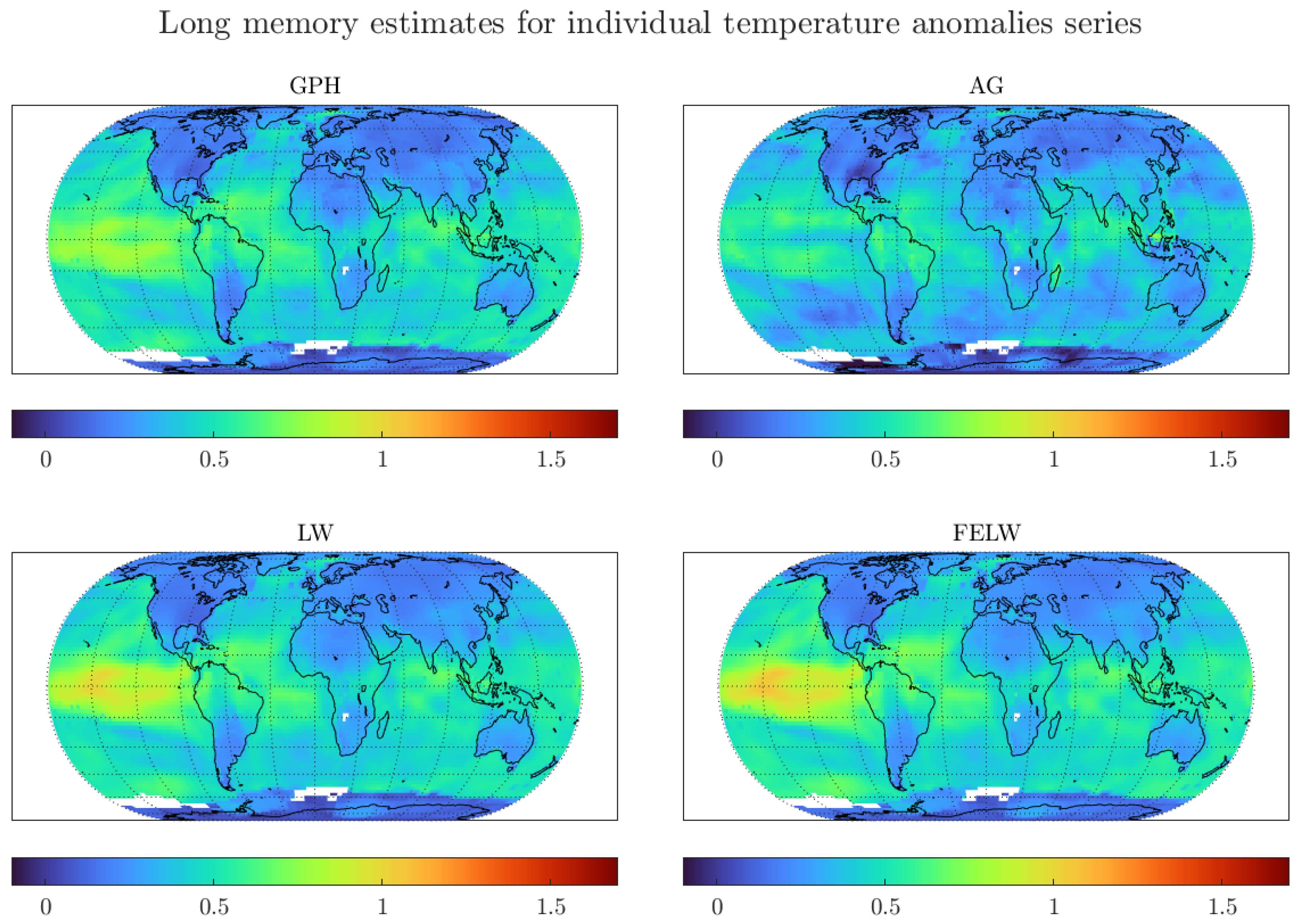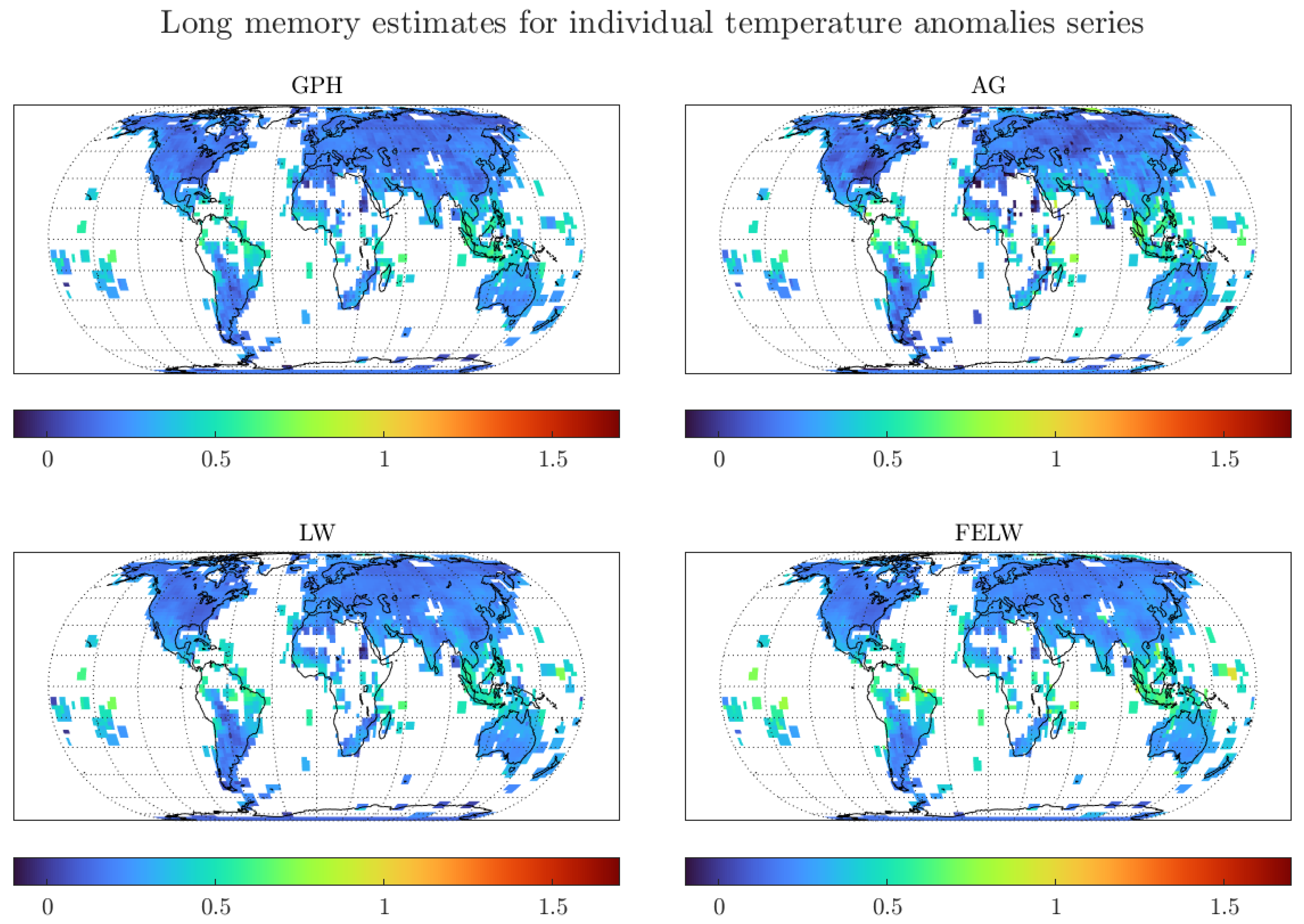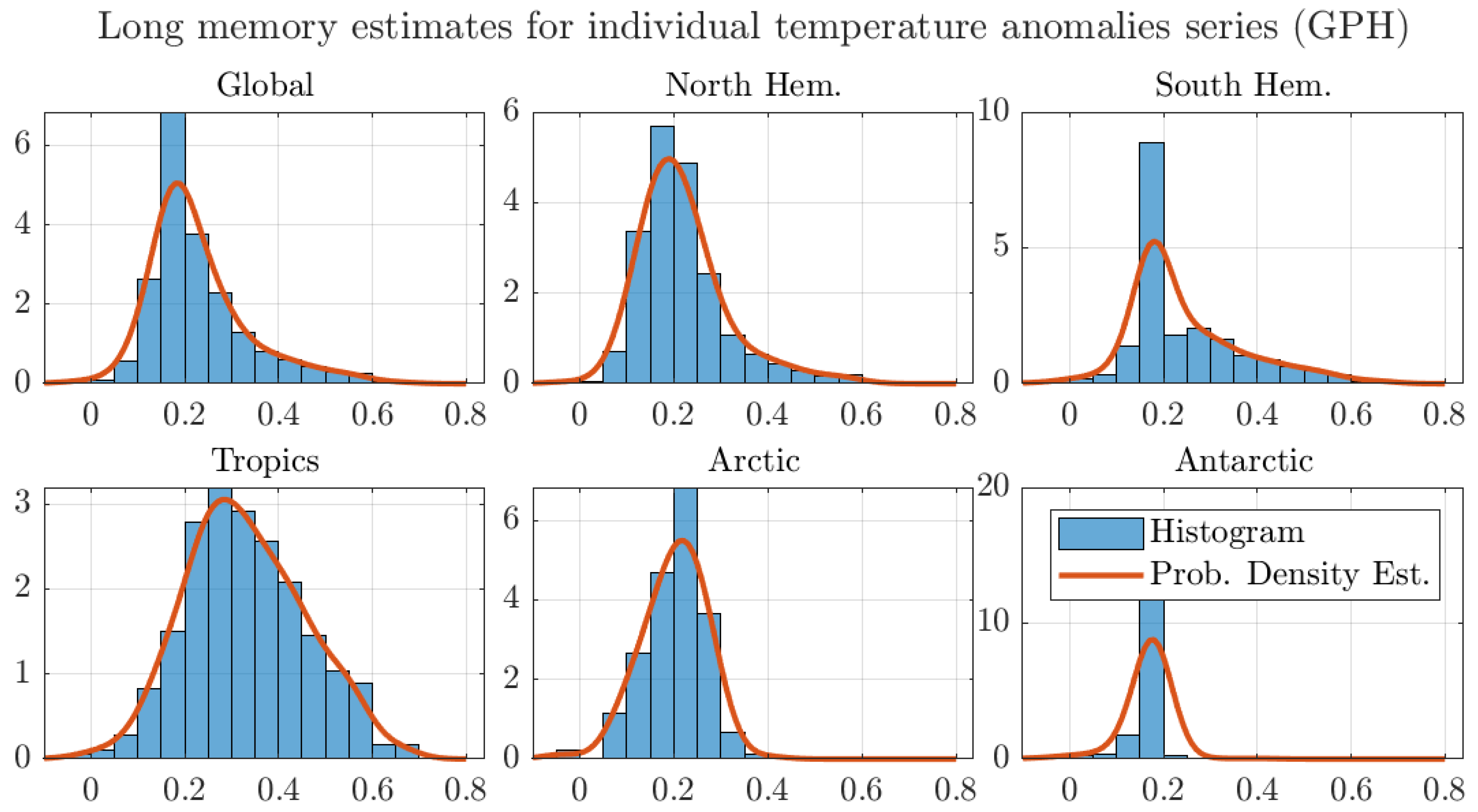This section shows the results from estimating the long memory parameter using semiparametric estimators in temperature anomalies data. We consider temperature anomalies in individual grids and compare them against regional and global averages. Our preferred method uses the optimal bandwidth and the larger monthly datasets. As a robustness exercise, yearly data, different smoothing radius, and values for the bandwidth parameter are considered.
4.1. Monthly Data with 1200 km Smoothing Radius and Optimal Bandwidth
Table 1 presents the long memory estimates from the monthly regional and global temperature averages computed by GISS; that is, the data presented in
Figure 2. The table also presents the standard deviation for all estimates. Recall that the standard deviations of the semiparametric long memory estimators depend only on the bandwidth and sample size. Given that all series considered in the table have the same sample size, the standard deviations are the same for all estimates.
The long memory estimates for the regional and global averages imply that they follow a nonstationary process, . Nevertheless, all long memory estimates imply processes that revert to the mean, . We will compare these values against the long memory estimates at all individual grids.
For illustrative purposes, the table shows the long memory estimates for the London grid series. The long memory parameters are statistically larger for the regional and global averages than for the London grid. In particular, all estimates from the regional and global averages are more than four standard deviations apart from the individual grid estimates. That is, the confidence intervals do not intersect, and are thus statistically different.
As previously discussed, GISTEMP contains individual temperature data for 16,200 grids. It will be unwieldy to present a table with long memory estimates for the temperature at all grids. Instead,
Figure 5 presents the results for all individual grid points in a global map for each estimator considered.
The figure presents some interesting findings.
First, the degree of memory is smaller for land than for ocean surface temperature. This could relate to the ocean’s larger ‘thermal inertia’ (see
Hansen et al. (
2010);
Sutton et al. (
2007)). The authors analyse the common finding that temperatures over land increase more rapidly than over the sea. In this regard, the larger thermal inertia manifests itself in larger degrees of memory.
Second, long memory estimates at individual land grids seem to be in the stationary range,
, particularly for grids besides Africa and South America. Thus, the degrees of memory near all individual land temperature grids are smaller than those for regional and global averages. The larger degree of memory for temperatures around Africa and South America could relate to increased uncertainty due to the smaller number of long temperature measuring stations in these regions, see
Peterson and Vose (
1997), and
Figure A2 in
Appendix A.
Third, besides a few ocean grid temperatures using the LW and FELW estimators, all long memory estimates are in the mean-reverting range, . This indicates that shocks to the temperature series seem to be non-permanent. This result has major implications in terms of the discussion regarding ways to mitigate climate heating. If the degree of memory of temperature data is in the mean-reverting range, we would expect the increase in temperature to revert in the long-run, provided that we implement climate heating mitigating policies.
Finally, the degree of memory of the London grid is in the same range as most of the land temperature grids away from the Equator. Moreover, the sample size for the London grid is comparable to the sample sizes for most of the individual grid series, see
Figure A2 in
Appendix A. Thus, the standard deviations for all estimates, reported in
Figure A3 in
Appendix A, are similar to those shown in
Table 1. In turn, the discussion regarding the statistical difference between long memory estimates at individual grid temperatures and long memory estimates for regional and global averages extends to most grid series. As previously argued, the London grid shows behaviour similar to other individual grids and its selection is done for illustrative purposes. The figures show that the results extend to most of the land temperature grids.
Overall, the results from
Figure 5 suggest that the long memory dynamics for the global and regional averages are greatly affected by aggregation, particularly due to the influence of temperatures at the Tropics. The estimates from the less reliable temperature measurements at Africa and South America, mixed with the higher degrees of memory of temperature at the oceans, propagate due to aggregation to the global and regional long memory estimates.
To shed light on the influence that aggregation and the temperature data at the Tropics has on the long memory estimates,
Table 2 presents averages from the long memory estimates in individual grid stations for selected regional subsamples. The table shows mean values for the long memory estimates for all grids, the global estimate as well as for grids in the Northern and Southern Hemispheres. Furthermore, the table shows long memory estimate averages for grids located in the Tropics, the Arctic, and Antarctic, that is, those between latitudes
and
,
and
, and
and
, respectively.
Table 2 presents some interesting findings.
First, the averages of the degrees of memory for global and regional temperature grids are smaller than the degrees of memory estimated for the aggregated data. In particular, the global average of the degrees of memory is almost half that of the degree of memory of the global temperature series. The smaller average degrees of memory can be explained due to the smaller degrees of memory estimated for most temperature grids, as shown in
Figure 5. This is in line with the aggregation argument explained in
Section 3.2, and it provides evidence that aggregation seems to be exacerbating the estimated degrees of memory for global and regional temperature series.
Second, the table broadly confirms that the degree of memory seems to be smaller as we move away from the Tropics. Only the average degree of memory at the Tropics seems to fall into the nonstationary range, and only for the LW and FELW estimators. Thus, the table suggests that the temperature at a few grids around the Tropics increases the degree of memory for the global and regional temperature averages.
Finally, the last column of
Table 2 shows the number of individual grids used to compute the regional averages. Note that each region’s number of grids is consistent with equally spaced grid points and a total number of grids of 15,981 once we remove the 219 with no more than 50 observations. That is, around 8000 grids for each hemisphere, or half the total, which is more than 5000 grids for the Tropics, covering a third of the world, and more than 2000 for the Arctic and Antarctic that cover approximately an eight of the globe.
The effect that the memory estimates around the Tropics have on the regional aggregates is further illustrated in
Figure 6. The figure shows histograms and estimated probability densities for the long memory estimates for all regions considered in
Table 2. For ease of exposition, the figure shows the estimates by the AG method and similar figures for the other estimators are reported in
Appendix A.
The figure shows that the probability density of the estimates around the Tropics puts more weight in the nonstationary range than the densities for the other regions. Using an analogous argument to the one in
Figure 4, this larger weight to nonstationary values results in a larger degree of memory for the regional average. The same effect can be observed in all regions. In particular, both the Arctic and Antarctic regional estimates assign almost no weight to the nonstationary region, which results in degrees of memory well inside the stationary range. Finally, the figure shows that the mean values are in the stationary range, as shown in
Table 2. As previously discussed, the aggregation argument explains the larger degree of memory of the aggregated series in comparison to the average of the degrees of memory of the individual grid series.
4.2. Monthly Data with 250 km Smoothing Radius and Optimal Bandwidth
Figure 7 presents the results for all individual grid points for the 250 km smoothing radius dataset and optimal bandwidth.
The figure shows that the long memory estimates are smaller for the smaller smoothing radius. In particular, almost all long memory estimates are in the stationary range. This once again points to the effect that aggregation has on the long memory estimates. The smaller smoothing radius corresponds to fewer temperature measurements in the averages, translating to smaller degrees of memory due to aggregation.
A thorough analysis of the long memory estimates and standard deviations, reported in
Figure A4 in
Appendix A, shows that the London grid results are not exceptional and are replicated for most land grids. In particular, the statistical analysis for the London grid extends to other grids.
The figure shows that there is information for fewer grids at the smaller smoothing radius, particularly at sea and around the Tropics. As previously discussed, these missing observations result from the fewer long temperature measuring stations in these regions (see
Peterson and Vose (
1997)). In turn, the smaller number of temperature grids translates into smaller degrees of memory for the regional averages, as shown in
Table 3.
To illustrate the effect that aggregation has on the regional averages,
Figure 8 shows the long memory histograms and probability density estimates. For ease of exposition, the figure shows the estimates by the GPH method. Similar figures for the other estimators are reported in
Appendix A.
The figure shows that long memory estimates for regions away from the Tropics put no weight to the nonstationary range. Following the aggregation argument, the smaller weight translates into smaller degrees of memory for all regional averages, particularly for the Arctic and Antarctic.
Overall, the results from the smaller smoothing radius agree with the results of our preferred method. Aggregation seems to exacerbate the long memory estimates of global and regional temperature averages. The smaller cross-sectional dimension associated to a reduced smoothing radius results in smaller degrees of memory for the individual temperature grids.
4.3. Robustness Exercises
This section presents the results from some of the robustness exercises considered in this study. In particular,
Table 4 and
Table 5 show results using yearly data for the 250 km smoothing radius dataset.
Table 4 presents the results using the optimal bandwidth, while
Table 5 uses the commonly used bandwidth given by
, where
T is the sample size.
The results from the robustness exercise broadly agree with the main results of this paper. That is, the degrees of memory of an individual grid series is smaller than for the aggregated series, and the degree of memory decreases as we move away from the Tropics. Nonetheless, the reduced sample size product of considering yearly observations increases the variance of all estimates, making them less reliable. Recall that the standard errors for the semiparametric estimators of long memory only depend on the bandwidth parameter and sample size. Thus, smaller sample sizes imply larger standard errors.
Decreasing the bandwidth also increases the variance of the estimates. Hence, the degrees of memory estimated in
Table 5 are even more uncertain than those presented in
Table 4. However, as argued before, they point to the same conclusions as those from the larger dataset.
Finally, note that the results from
Table 5 are in line with the ones from
Mangat and Reschenhofer (
2020). The authors use some of the semiparametric estimators considered in this study along with the small-sample estimator developed by
Reschenhofer and Mangat (
2020). Using the same sampling frequency and bandwidth, the authors found that global and regional temperature series fall into the nonstationary range. Furthermore, the authors found some of the long memory estimates for regional temperature series to imply processes that do not revert to the mean,
. Our analysis suggest that these results may come from a small bandwidth and sample size.
Additional robustness exercises considering all combinations of the sampling frequency, smoothing radius, and bandwidth all point broadly in the same direction, and they are available upon request.


